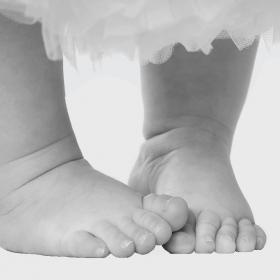A mother watches as her daughter, Abi, takes her first steps, and begins her own journey at the same time.

If I angled the wheels just right, I could fit the walker into the back seat of my car. It was a huge, weighty, metallic purple contraption that clack-clack-clacked when it rolled. I loved that sound. It meant that my daughter, Abi, was walking.
Yet that morning, as I looked at the walker, I sweated. For I was about to take it out to a birthday party filled with typically developing kids and their parents … for the first time.
Flash back one year. Abi was 18 months old and couldn’t sit up or bear weight on her feet. She had no fine-motor control. Doctors didn’t know why. She was smaller than a standard growth chart could map, and she was floppier than a newborn. By five months old, she’d started physical therapy, occupational therapy, and play therapy. At 18 months, her schedule included speech therapy. I didn’t know then if my daughter had “special needs.” I did know that I felt isolated and desperate for understanding. I’d already watched Abi’s playgroup friends start to crawl, then cruise, then run and climb, some by nine months of age. I clearly remember one 15-month-old plucking a single blade of grass and drawing it through her forefinger and thumb like an expert weaver.
Then I discovered the infant/toddler program at CHIME in Northridge, Calif., a pre-preschool for children with special needs and their caregivers. The morning we arrived, children were sitting at tables, gluing, painting, and using chalk. I propped up Abi on the floor with some toys, and sat behind her for support. Well, I thought, she’ll probably learn a lot by watching.
The staff physical therapist came to meet us. She evaluated Abi. And she said, “We need to get her standing.” To my shock, she meant now.
A shed door was opened. There stood a tangle of metal and wheels.
Hateful terms like “pitiful,” “crippled,” and “Tiny Tim” elbowed each other in my mind. I watched as Abi was strapped into a bulky, padded chest support, tubular metal encircling her. This was the “gait trainer,” a massive walker with a chubby, little person in the middle of it.
Then, that little person budged that big piece of equipment, marking the tiniest, most easily missed, most thrilling first step I’d ever seen.
Abi used the gait trainer every day at school. The chest support was soon removed. Before long, whenever Abi heard it clack-clack-clacking out of the shed, she’d shriek with excitement. But that equipment stayed at school. When our family went places, Abi would ride in her stroller. The walker was enormous, and so were the damp, heavy clouds of remarks I imagined Abi would hear if she used it outside of CHIME.
Near Christmas, my husband and I attended a CHIME fund-raiser. A parent onstage said, “I don’t even notice adaptive equipment anymore.”
Yeah, right, I thought.
In public, Abi was carried. At the park, I would sit her in an infant swing, support her in a sandbox, or stand her up in front of any table she could grip for balance. At a friend’s second birthday party, Abi could only cling to a bench, and watch.
It was now spring break, and we’d been invited to another birthday at a nearby park. But this time, something was different. On the last day of school before break, Abi’s teacher had asked, “Would you like to borrow the gait trainer?”
So that sunny morning, my husband and I took a deep breath and hefted the gait trainer into the back seat.
The equipment shone from the top of the paved hill where Abi stood, looking down at the party below. Then, she gripped the handles, grinned, and ran toward the action. Children stared as she whizzed into their midst. Then, one after another, they asked, “Can I have a turn?”
The whispers and sad sighs I’d imagined never came. Adults did ask about Abi. Then, they told me their disability stories. Many knew someone. Many were those someones.
A year later, we’re accustomed to stopping on every walk for people who want to high-five Abi, praise her, and sometimes bless her. A stranger on his cellphone stopped a conversation one morning to kiss the top of her head. A man in a wheelchair said Abi was an inspiration to him. The next time we saw him, he was using a walker “because of her.” Children ask, “Why does she use that?” I tell them, “It helps her walk.” Inevitably, they nod, then ask, “Can I try it?”
I’ve never stopped seeing the equipment. And I don’t want to. For I’ve finally learned to see it the way Abi does: as an attention-grabbing, clack-clacking, space-consuming, zoom-zooming, totally wonderful tool to reach the world.
Jamie Kiffel-Alcheh ’98 is the author of several children’s books for readers of all abilities, including the board book Can You Hear a Coo, Coo? She’s also a regular contributor to National Geographic Kids.


